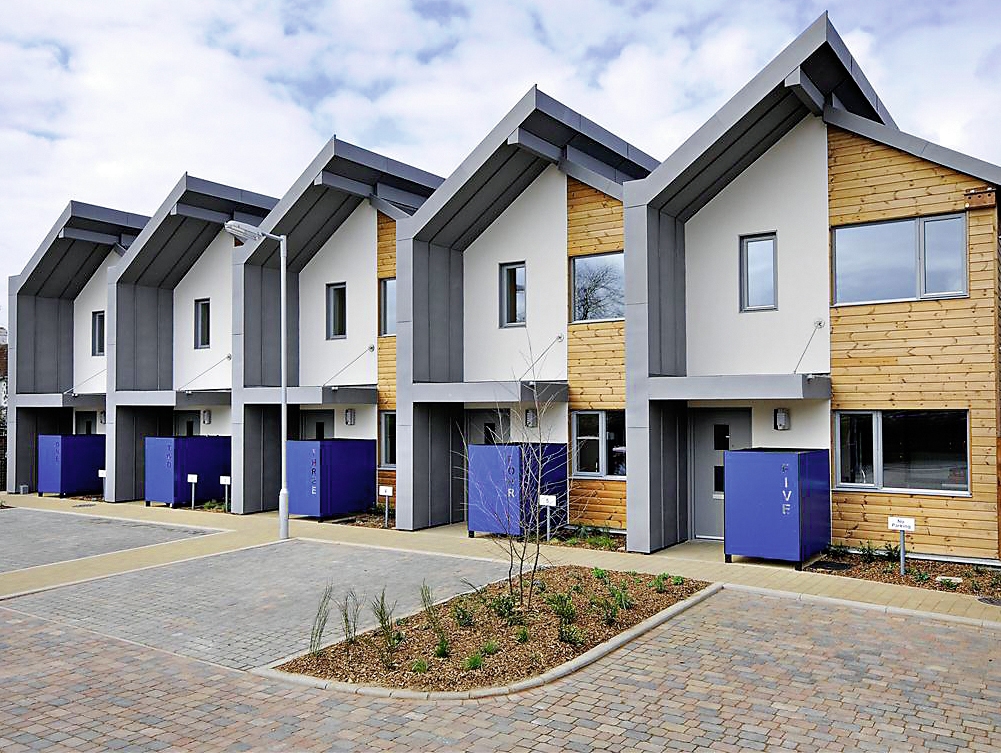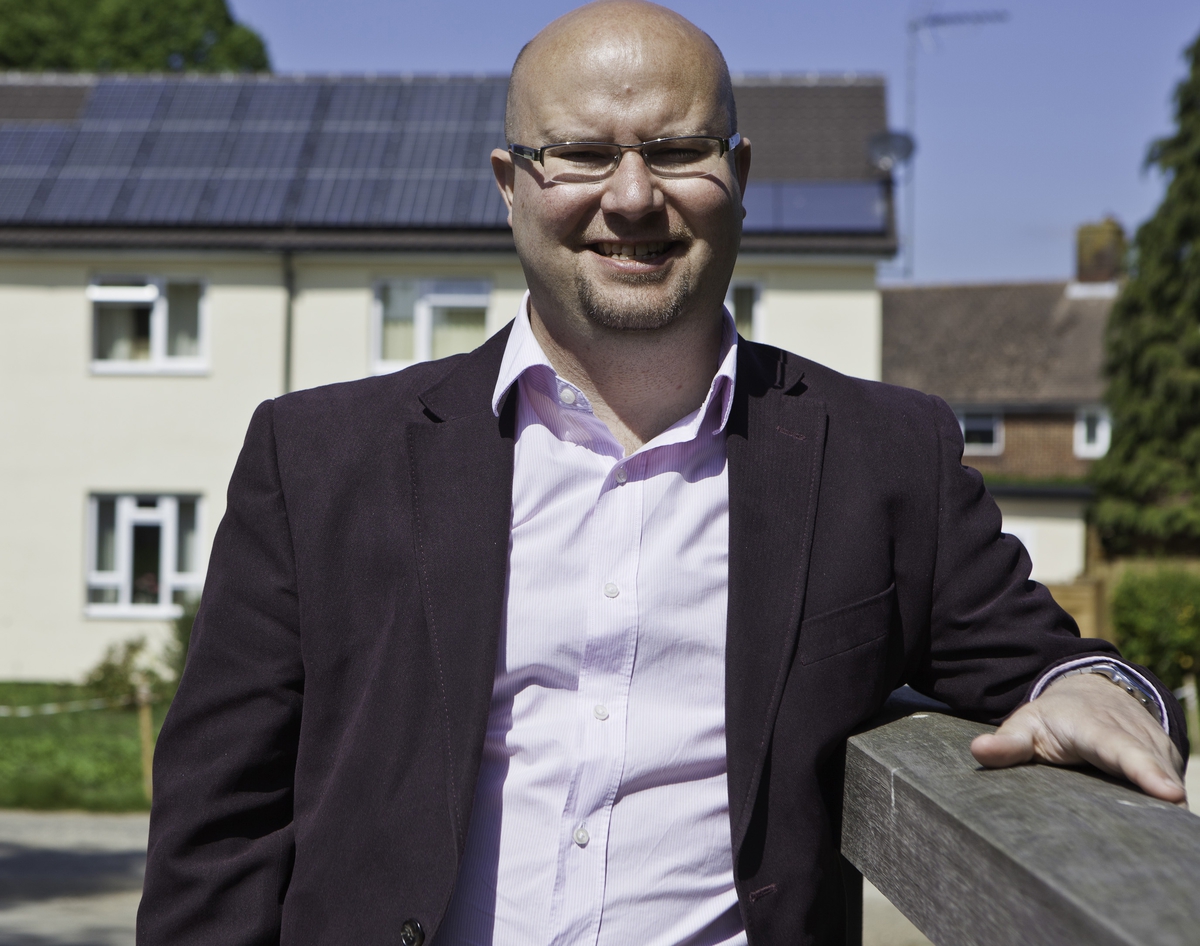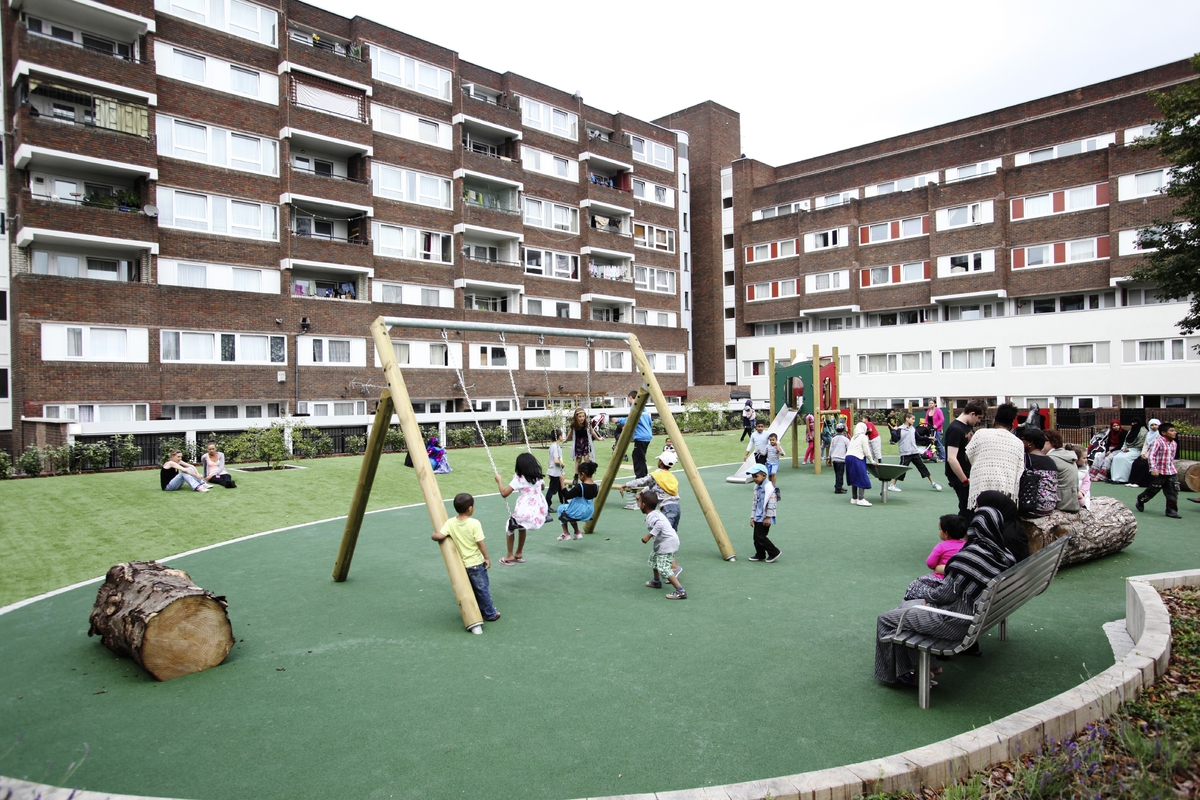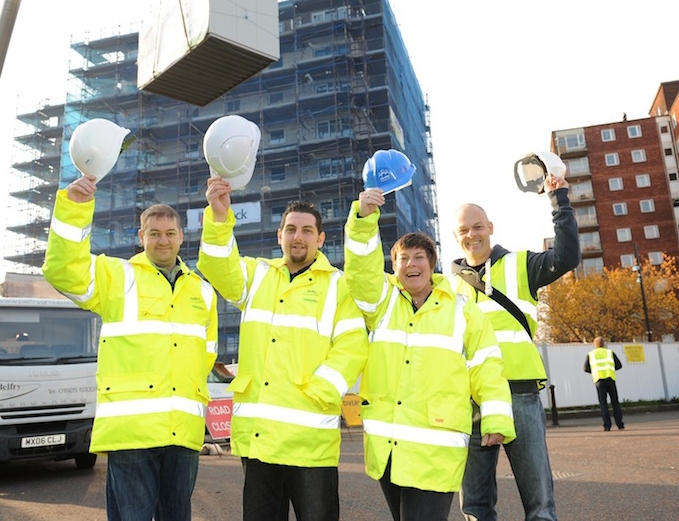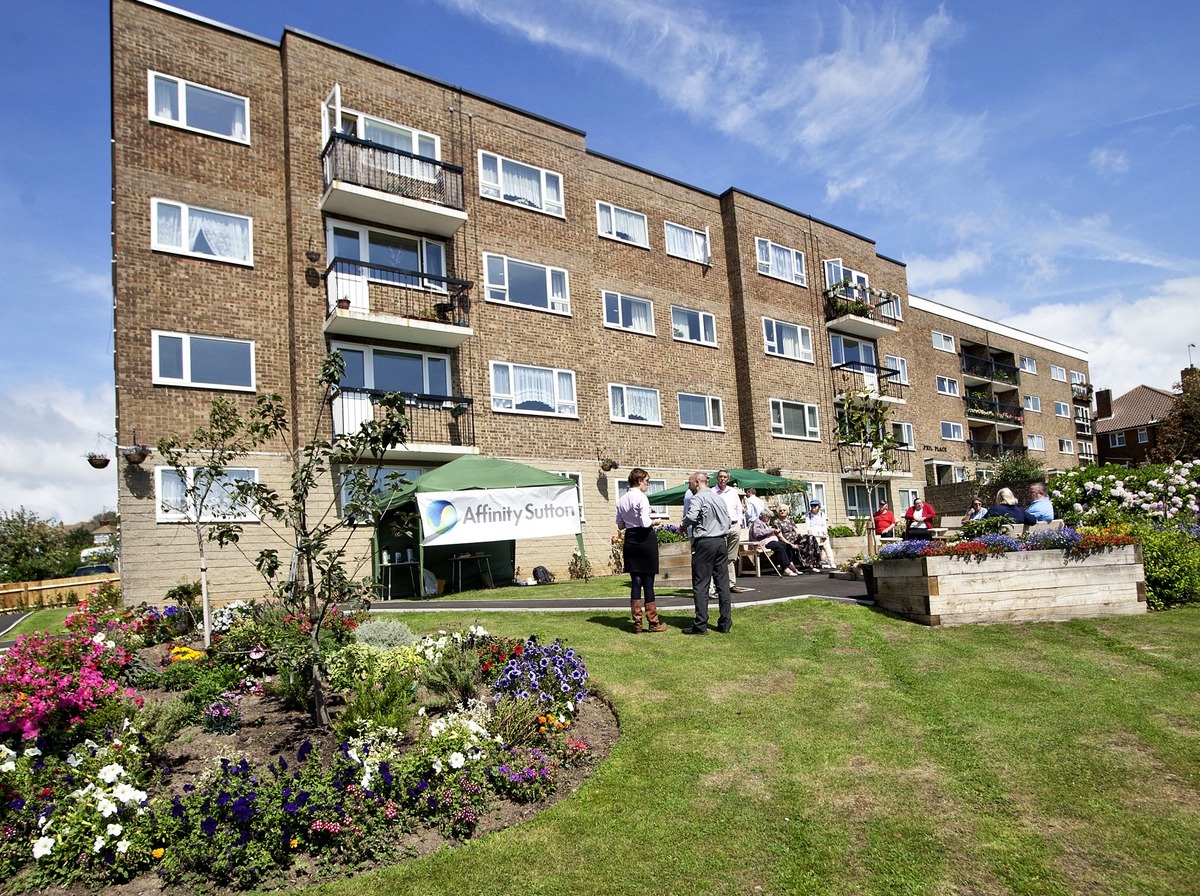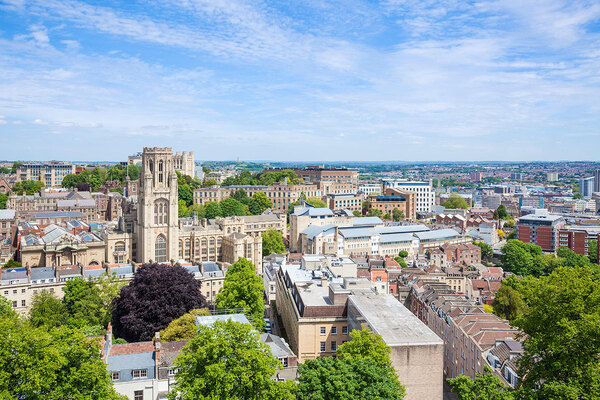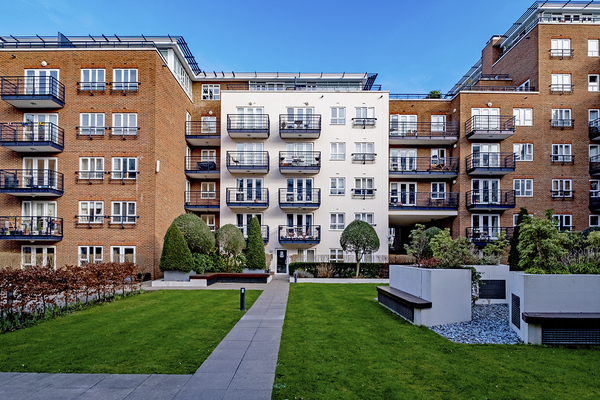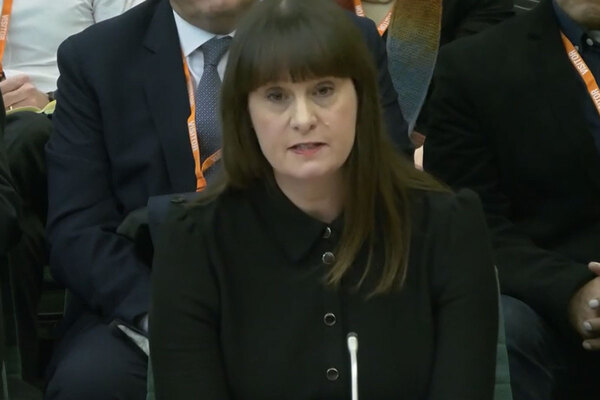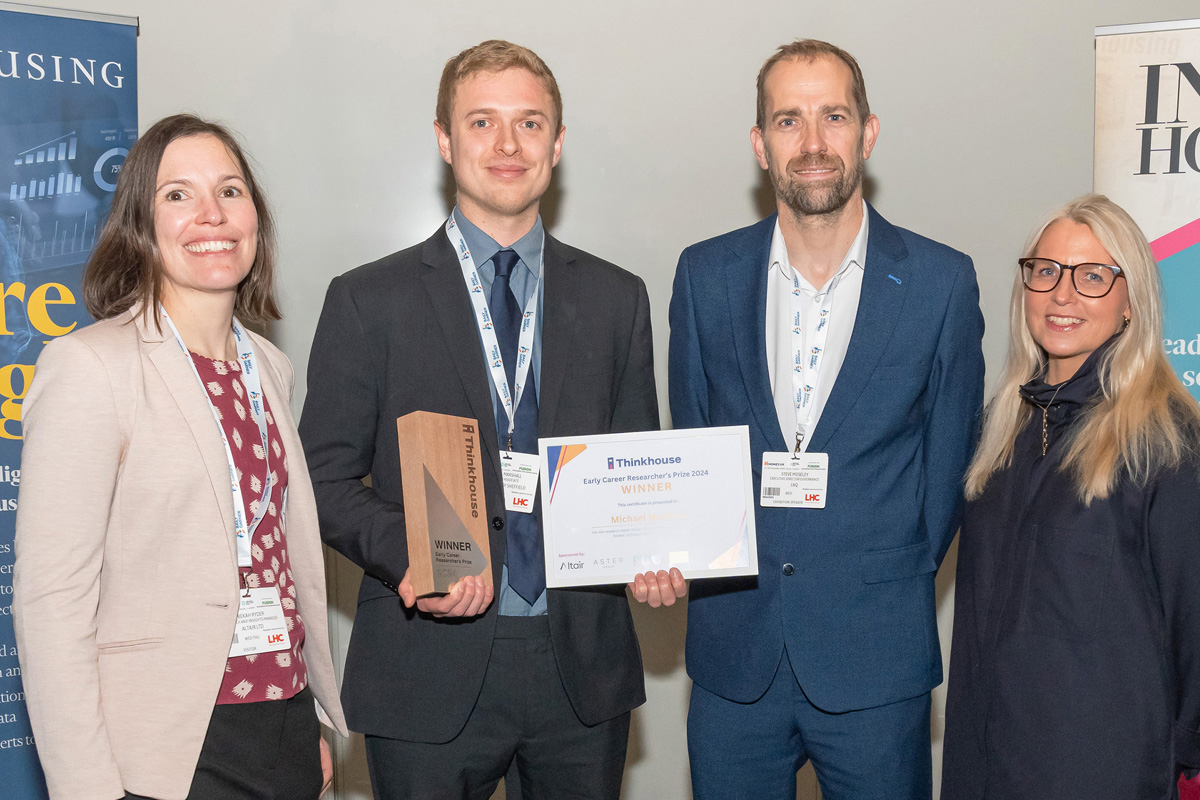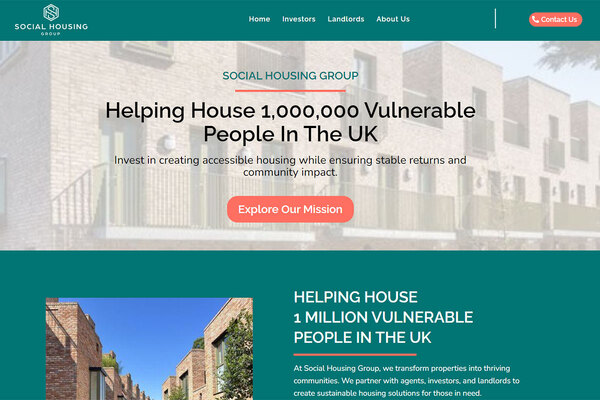Sustainable Housing Awards 2012
From water-saving initiatives and glycerol-fuelled power plants to community-owned solar power stations and beehives, the winners of this year’s Sustainable Housing Awards demonstrate the very best in eco-technologies and environmentally friendly ideologies. Chloë Stothart reports
Social housing provider of the year - Innovative approach to green homes award
Sponsor: VPhase
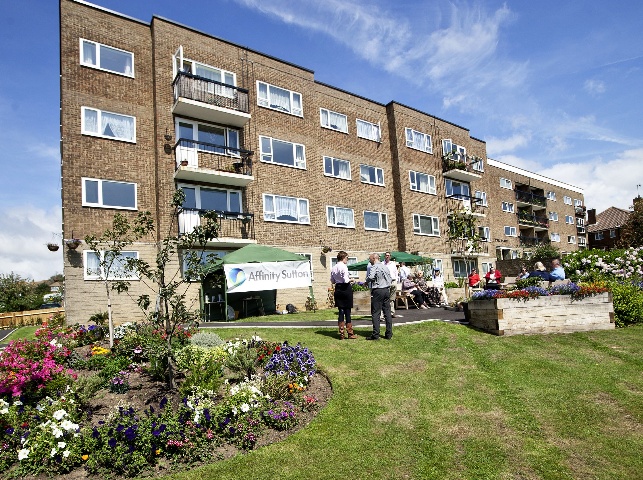
Source: The Brighton&Hove Studio Ltd
WINNER: Affinity Sutton
WHERE: Nationwide
QUICK ECO-CREDENTIALS: Affinity Sutton’s £1.2 million Future Fit programme of making and measuring energy improvement to homes has useful lessons for the green deal. At the same time it has worked on the UK’s largest carbon-neutral development and helped residents to save energy and improve the look of their estates
WHAT THE JUDGES SAID: “The work they have done is fantastic. We liked that the programme was large scale. Affinity Sutton is informing government policy as large organisations should do - pioneering.”
The Future Fit programme involves the refurbishment of 102 homes across 22 property types around the country, which are typical of nearly 70 per cent of Affinity Sutton’s 57,000 homes. The work, which includes air tightness improvements, internal insulation, new boilers, zoned heating and solar photovoltaics, was undertaken to one of three budgets - £6,500, £10,000 or £25,000 per unit - to see what can be achieved for the money. Homes are being monitored for a year for performance and savings.
Key green features
- So far the project has found the works cost about £3,000 more than the value of the energy savings. The findings have implications for the green deal, which requires the cost of improvements to be lower than the value of energy saved, known as the ‘golden rule’.
- It also found that the £6,500 package, which is similar to work that would be done under the green deal, achieved only an 18 per cent reduction in CO2 emissions, just 4.8 per cent of more than 800 people targeted initially responded to the offer of free works and 23 per cent of people dropped out between signing up and the completion of the works.
- Affinity Sutton is a member of the Department of Energy and Climate Change’s green deal providers steering group.
- Its joint venture with house builder Linden Homes and the Homes and Communities Agency will produce the UK’s largest carbon-neutral development of 75 new and converted homes and community facilities at Graylingwell Park in Chichester.
- Its £600,000 Improving the Appearance of our Estates programme involved residents in consultation and activities to improve the landscaping and environment where they live.
- The Great Outdoors project held 38 planting events on estates, in schools, community centres and sheltered housing schemes for 600 residents. Bulbs and gardening equipment were given to several groups so they could continue planting work on their estates.
- Affinity Sutton’s Energy Fit programme trained front line staff in fuel poverty awareness and provided a toolkit to help residents reduce their energy bills.
- The Green Your Community scheme will provide energy efficiency and retrofit packages for community centres and provide learning centres for staff, residents and other local people to understand and reduce their energy use.
Sustainable smaller social housing project of the year (fewer than 25 homes)
Supported by: Housing 2013 Conference and Exhibition
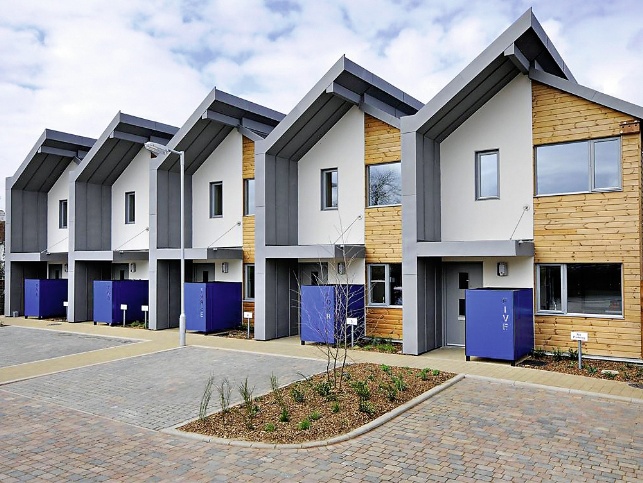
WINNER: Radian
WHAT: 11 zero carbon homes for social rent
WHERE: Stoneham Green, Southampton
QUICK ECO-CREDENTIALS: Southampton’s first carbon-neutral homes will more than offset their emissions with the electricity generated by their photovoltaic panels
WHAT THE JUDGES SAID: “We loved the community approach in this true zero carbon development. We liked that it was an old allotment site, and the fact it had very good U values [the rate of heat loss through materials].”
With anticipated fuel bills that are half that of a home constructed to minimum building standards and water use per person expected to be just under half the average, these 11 homes are very environmentally friendly.
Key green features
- The scheme is the first in the Southampton area to reach level 6 of the code for sustainable homes.
- All its five two-bedroom and six three-bedroom houses also meet the lifetime homes standard.
- The previously derelict site once housed a disused community centre and allotments that had not been cultivated for more than 20 years.
- Slow worms and grass snakes on the site were rehoused to a suitable habitat nearby.
- The houses are highly insulated and triple glazed with a U value - the rate of heat loss through materials - of 0.11 for the roof, floors and walls - far better than the 0.30 required by building regulations.
- They are also very air tight with an average air change of 1.68 m3/hm2 at 50 pascals. They use mechanical ventilation with heat recovery to heat the air supply to the living rooms and bedrooms with the warmth of air from the kitchens and bathrooms.
- A communal biomass boiler provides heat and hot water and electricity comes from photovoltaic panels on each home.
- Each home has a building energy management system. This allows residents to monitor energy use as well as a real-time bus timetable to reduce car use.
- To reduce construction waste, the team reused their site security fencing and existing drainage connections where possible.
- Use of water-saving devices, such as aerated taps and rainwater collection butts, is expected to cut daily water use to 75.22 litres per person, which is nearly half the average level as estimated by water conservation body Waterwise.
Sustainable housing finance initiative of the year
Sponsor: Wates
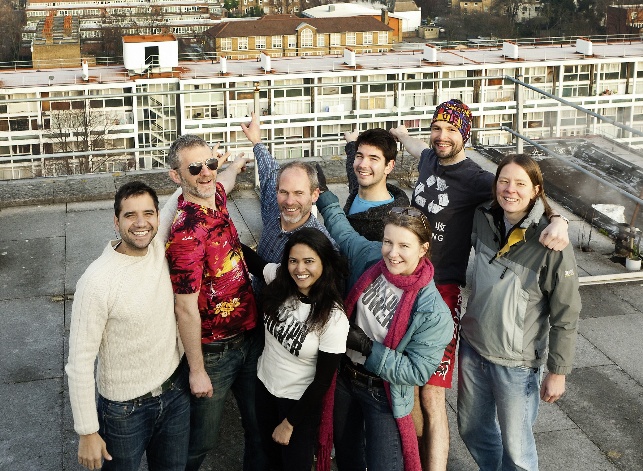
WINNER: Brixton Energy
WHAT: Community-owned solar power station
WHERE: Brixton, London
QUICK ECO-CREDENTIALS: Uses local investment to generate solar electricity and keeps the financial returns in the community
WHAT THE JUDGES SAID: “This is an outstanding winner. The project is genuinely innovative in terms of funding. It shows the deepening social impact of the green project.”
Key green features
- Repowering South London, a group of residents, set up Brixton Energy Solar 1 as a co-operative to install a major solar power station in the area.
- They raised £60,000, partly from 103 locals who became community shareholders and will get a return through the feed-in tariff. The government’s local energy assessment fund will provide £34,300 to help install a 37 kilowatt-peak solar photovoltaic system on the roof of Elmore House - a Lambeth Council-owned block managed by United Residents Housing - to generate an estimated 21,000 kilowatt-hours of electricity per year.
- The panels power the lift, providing residents with a small reduction on their service charge, and surplus power is exported to the national grid, offsetting 13 tonnes of CO2 annually.
- The feed-in tariff will also support a community energy efficiency fund which will pay for energy-saving workshops and provide low-cost energy-saving measures and training.
Sustainable larger social housing project of the year (more than 25 homes)
Sponsor: United House

WINNER: The Tooley & Foster partnership
WHAT: 16 houses and 12 flats
WHERE:New Cranes Court, Basildon
QUICK ECO-CREDENTIALS: A traditional look conceals top level eco-technology in this new development
WHAT THE JUDGES SAID: “The final code for sustainable homes certificate was impressive. We liked the reduced construction waste and also the approach to the design. The layout looked nice and the feel was good.”
New Cranes Court is carbon neutral, has the top rating under the code for sustainable homes and is powered by Britain’s first glycerol-fuelled combined heat and power plant.
Key green features
- Planners required New Cranes Court to look fairly traditional in order to fit in with a nearby listed church. However it meets level 6 of the code for sustainable homes, which requires it to be carbon neutral when inhabited.
- The scheme won maximum points under the code for energy efficiency, water usage, surface water run-off, waste management, pollution and management and scored 60 per cent to 95 per cent on other categories.
- The construction is energy efficient, using a highly insulated, timber frame panel system which prevented heat loss through thermal bridging. U values, which measure heat loss through materials, for all external elements were very low at 0.1 to 0.13 while air tightness was two cubic metres per square metre at 50 pascals - much better than building standards of 10, which require an airtightness of 10 cu/m2 at 50 pascals.
- Hot water and electricity are supplied by the first combined heat and power plant in Britain fuelled by glycerol, a waste product from biodiesel generation, which emits little CO2 and pollution and is water soluble.
- The scheme’s mechanical ventilation heat recovery system has an efficiency of 92 per cent measured under the standard assessment procedure for energy rating appendix Q, which covers the performance of many newer technologies.
- The properties have smart meters to help residents keep track of energy use.
- Water-efficient toilets, taps and showers helped the development win maximum code points on water conservation.
- Construction waste was minimised by using one bathroom type and two shower room types throughout the scheme plus a standard floorplan for both blocks of flats.
- The central staircase with windows and roof lights on the top floor allows through ventilation to cool the house and gives a simple duct layout for ventilation equipment. Windows on opposite walls on living rooms and kitchens give cross-ventilation.
The transformation award
Supported by: Sustainable Housing
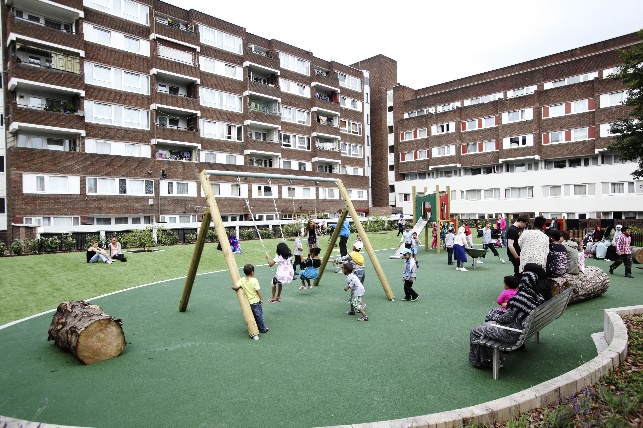
WINNER: Leopold Park, East London - Poplar Harca
QUICK ECO-CREDENTIALS: The £1 million transformation of a rundown park on a deprived estate created an easily maintained space with something for residents of all ages
WHAT THE JUDGES SAID: “You can see a dramatic transformation for the people living there - great result.”
Key green features
- Housing association Poplar Harca worked with residents to improve Leopold Park as part of the regeneration of Leopold estate. It had been a neglected area of green space and trees.
- The landlord and the residents on the estate board were keen the revived park should not be a focus for anti-social behaviour or fall into decline as some other green spaces on the estate had done. They used robust materials, including artificial grass, as part of the park is above an underground garage and real grass might die quickly. The plants are hardwearing, easily maintained and complement existing trees.
- The final design included a children’s playground, bird and bat boxes and natural play features, such as logs, to encourage insects and biodiversity.
- There is a water feature in the central sitting area for older residents.
- Cuttings are mulched and reused and no pesticides or peat are used.
- The chair of the residents’ estate board said the whole estate felt the positive effects of the transformation of the park.
Social housing provider of the year - corporate sustainability award
Sponsor: NHBC

WINNER: Aster
WHAT: Housing association with 17,000 homes
WHERE: South and south west England
QUICK ECO-CREDENTIALS: A range of targets and initiatives has helped Aster cut its carbon footprint by more than 6,000 tonnes in three years, reduce water use by 750 litres a day and increase office recycling by up to half
WHAT THE JUDGES SAID: “They set tough targets and showed how they achieved them. It’s very good that all the staff have mandatory training and sustainability targets.”
Key green features
- Aster’s sustainability goals include reducing its CO2 levels by 80 per cent of 1990 levels by 2050, increasing recycling to 75 per cent by 2020 and cutting water use by a fifth by 2030 from 2008 levels.
- Each office has a ‘green team’ with a budget and half a day each month for green initiatives. So far, these have included composting food waste and green waste from outside the office, provision of better recycling bins and installation of secondary glazing in a small office.
- Aster has built a new office incorporating ground source heating, natural ventilation, rain water harvesting and recycled carpeting.
- The association’s ‘travel smart’ webpage provides calendars for car sharing, plus maps and public transport information.
- The landlord has also helped residents to save energy, trained them as energy advisors and given money to local environmental projects.
Sustainable housing consultancy of the year
Sponsor: Higgins

WINNER: Verco
WHAT: Employee-owned environmental consultancy that aims to practise what it preaches
WHERE: Nationwide
QUICK ECO-CREDENTIALS: Verco’s research and assessments have helped campaigns against fuel poverty, influence the green deal and numerous energy-efficiency programmes
WHAT THE JUDGES SAID: “The approach they take is very detailed and very strong on evidence. The work they do is ambitious.”
Key green features
- A participant of the Department for Energy and Climate Change’s green deal working groups, Verco has also undertaken work on the scheme for the National Housing Federation, Affinity Sutton, Guinness and London & Quadrant.
- Its research for the Energy Bill Revolution Campaign, an alliance of 84 charities, campaign groups and other organisations, lobbied for a £6,500 grant to every fuel-poor household to pay for energy-efficiency measures - enough to bring 90 per cent of them out of fuel poverty - paid for by existing carbon taxes. This could save up to four times as much CO2 from homes as the government’s energy-efficiency schemes while creating up to 200,000 more jobs.
- Verco has also bought a hybrid car for employees to use at one office, another office has joined a car club and it has installed video conferencing to reduce travel to meetings.
- It is working on a low carbon fit-out of its London office and has a beehive in its Overmoor office.
Sustainable smaller housing retrofit project of the year (fewer than 25 homes)
Supported by: Homes 2012
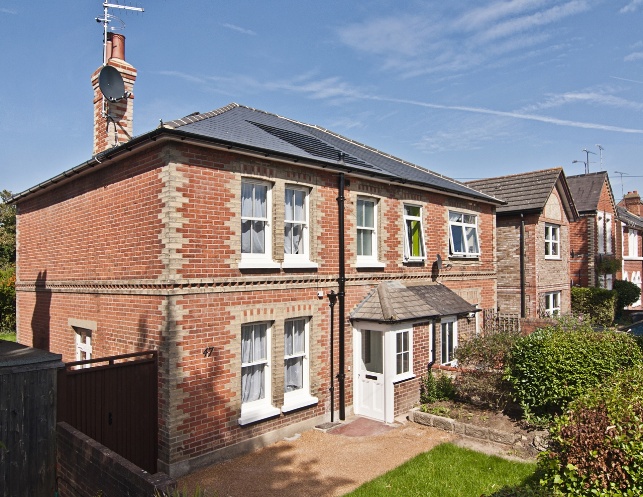
WINNER: Catalyst Housing
WHAT: Eco Homes project to retrofit two empty Victorian houses
WHERE: Wokingham, Berkshire
QUICK ECO-CREDENTIALS: Two Victorian homes retrofitted in different ways: one where costs were kept as low as possible and the other where performance came before budget
WHAT THE JUDGES SAID: “We like that this is replicable, and that they thought about the materials. We felt engagement was good.”
Key green features
- The ‘low-cost’ house should cut CO2 emissions by 83 per cent at a cost of about £60,000 using measures like low-energy lamps, internal wall insulation, 325 metres of loft insulation, photovoltaic panels, solar thermal collectors improved doors and solid ground floor insulation.
- The high-performance house is expected to cut CO2 emissions by 91 per cent with measures including insulation in suspended timber floors, a log burning stove, a condensing boiler, under floor and zoned heating, for a cost of more than £63,000.
Green social housing champion of the year
Supported by: Chartered Institute of Housing
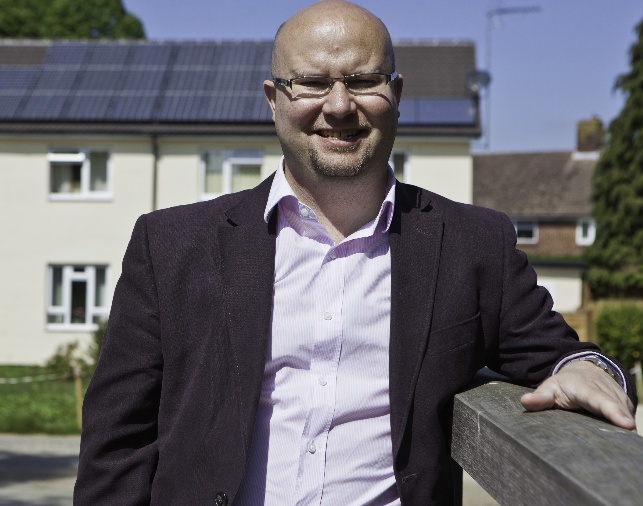
WINNER: Paul Ciniglio - First Wessex
QUICK ECO-CREDENTIALS: A social housing eco stalwart, Paul Ciniglio has run scores of major retrofit programmes and shared his knowledge with thousands of people
WHAT THE JUDGES SAID: “Paul has shared his knowledge and we are the better for it. He’s somebody who tries to make other people successful. He’s willing to take risks. Outstanding.”
Paul Ciniglio has worked in the construction industry for 28 years, including 16 at housing associations and councils, and given talks to thousands of people to share knowledge from his projects.
He joined BRE’s steering groups for the code for sustainable homes and EcoHomes XB and the Sustainable Homes working group.
He helped Radian install the first ground source heat pumps in UK social housing in 2006 and carried out the first refit of a street of social housing to advanced standards in 2007 with the Energy Saving Trust. He has worked on major photovoltaic demonstration projects and piloted new technologies in social housing, such as waste water heat recovery and endothermic, whole-roof based heating systems.
Mr Ciniglio has even welcomed more than 500 visitors to his own home, Sunpower CO2ttage, which he retrofitted in 2009, reducing his household emissions to 270kg of CO2 in 2011/12.
In 2012 he became sustainability strategist for First Wessex where he is applying insulation to 900 solid wall homes, launching a ‘green doctor’ scheme, delivering a £4 million photovoltaic project and preparing the organisation for the green deal.
Sustainability innovation award
Sponsor: Rockwool

WINNER: Ecopod heating system - Belfry
WHAT: A heating system for tower blocks and other large buildings providing cheap, sustainable energy
WHERE: Nationwide
QUICK ECO-CREDENTIALS: Designed to tackle fuel poverty, cut CO2 emissions and save money, the Ecopod has won numerous awards and the backing of one of the UK’s largest construction firms
WHAT THE JUDGES SAID: “A great innovation with big potential, this project solved some real problems with retrofit.”
Key green features
- Belfry’s managing director designed the Ecopod after visiting an elderly resident of a tower block who boiled water to wash because she could not afford to use her immersion heater.
- The Ecopod uses solar thermal panels to provide free heating for hot water, combined heat and power units, biomass, gas absorption air source heat pumps and cascade boilers in a single plant room and can be retrofitted to social housing, hospitals and student accommodation.
- At Chartist House in Hyde, it cut heating bills by 43 per cent annually and more than halved the tower’s carbon footprint to 69,000kg a year.
- The system cuts gas and boiler testing in each flat and can earn the landlord £3,000 to £5,000 a year through the renewable heat incentive.
- Construction giant Carillion will sell Ecopod worldwide.
Sustainable social housing contractor of the year
Sponsor: Profile 22
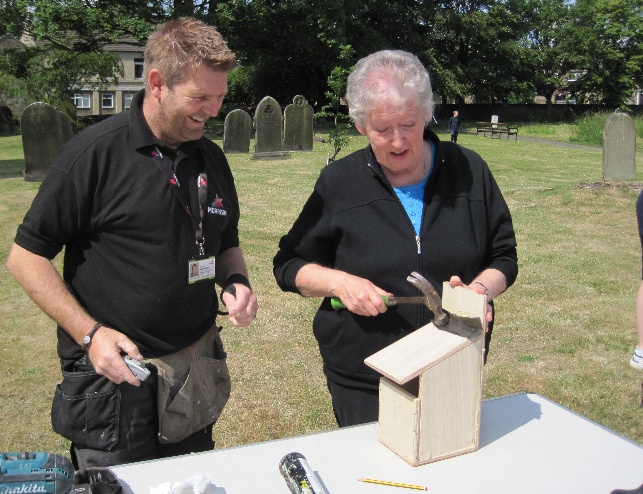
WINNER: Morrison
WHAT: A national social housing contractor that has worked with its clients to improve sustainability
WHERE: Nationwide
QUICK ECO-CREDENTIALS: Morrison aims to cut its carbon dioxide emissions by a fifth and is cutting waste to landfill and emissions from its vehicles
WHAT THE JUDGES SAID: “A very good effort that is really impressive in terms of community engagement. We liked how they explained their statistics.”
Key green features
- Morrison aims to cut its CO2 emissions by 20 per cent by 2014 and has achieved a 15 per cent reduction since 2009/10. However, the firm is now including emissions from supplied materials and waste which has given a new, increased emissions figure.
- It has cut waste sent to landfill by 10 per cent on one site and increased recycling.
- It has also reused old materials in its apprentice training programme which has diverted 1.3 million tonnes of material from landfill. The firm also wants to redistribute items to tenants in need.
- It employs 172 apprentices and offers work experience, local employment workshops and initiatives to help ex-offenders and older people into work.
Low energy social housing project of the year
Sponsor: H+H
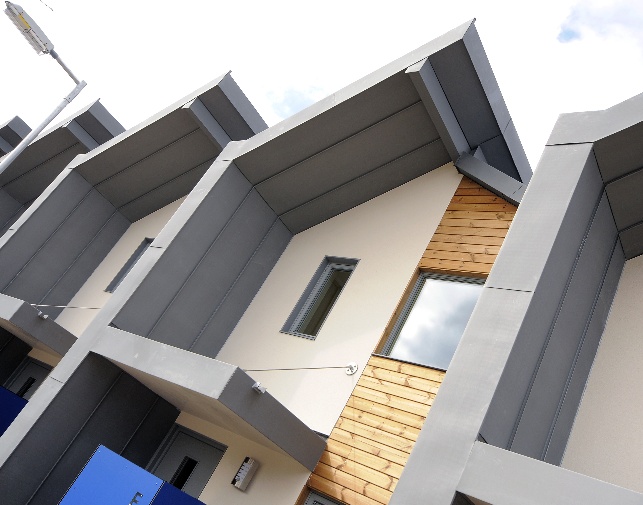
WINNER: Radian
WHAT: 11 new homes for social rent meeting level 6 of the code for sustainable homes
WHERE: Stoneham Green, Southampton
QUICK ECO-CREDENTIALS: These low-energy homes should halve residents’ fuel bills
WHAT THE JUDGES SAID: “This scheme is trying to raise the bar on energy use. It is a good demonstration for savings for residents, which is strong across the board.”
This is the first scheme in Southampton to reach level 6 of the code for sustainable homes and also complies with the lifetime homes standard, which aims to make homes as adaptable as possible to changes in residents’ mobility. Radian wanted to design homes that required little energy to run before installing low carbon and renewable energy technologies to offset and reduce emissions further.
Key green features
- A mid-terrace house in the development is expected to use 80 per cent less heat than a home meeting building regulations.
- Each home is expected to have fuel bills of less than £500 a year - half that of a home constructed to building regulations.
- Residents should save £5,500 a year in energy costs.
- The scheme cost about 20 per cent more to build than one constructed to building regulations and the development is expected to generate about £13,500 a year from the feed-in tariff.
- Radian expects to get a return on investment on the development in under 20 years, based on the energy saving and generation income versus the additional build costs.
- The site is forecast to generate more than 32 megawatts of energy from each photovoltaic array which can be used in the homes or exported to the national grid.
- Over a two-month period, 250 people have been on training sessions in the site’s open house, which is used to demonstrate the technologies in the homes.
Sustainable housing partnership of the year
Supported by: Inside Housing
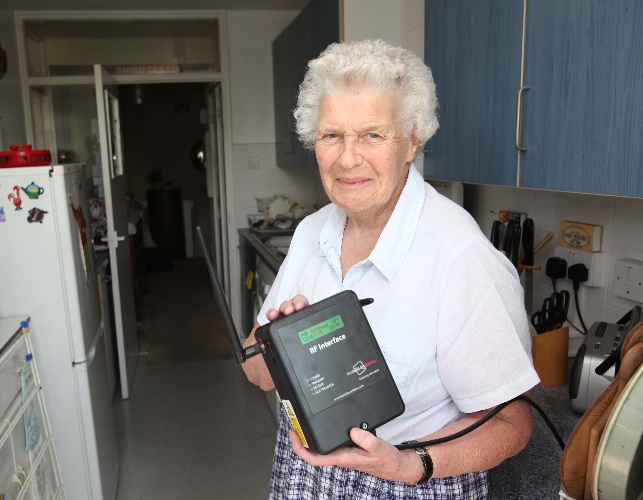
WINNER: Eco homes project - Poplar Harca
WHAT: A smart metering project in 16 homes with energy use displayed live in a specially refurbished community centre
WHERE: East London
QUICK ECO-CREDENTIALS: A smart metering pilot that was set up in just six weeks
WHAT THE JUDGES SAID: “This is an ambitious, clever use of an existing partnership. We are impressed at how Poplar Harca got 11 people round the table.”
Key green features
- Poplar Harca worked with the Institute for Sustainability, arm’s-length management organisation Tower Hamlets Homes, smart metering firm Optimum Consulting, data analyst Brite Green, residents’ estate boards and community groups, plus funder the Energy Saving Trust to install home energy management systems in 16 homes on different estates.
- The data is displayed live on a screen in an estate building which Poplar Harca refurbished as a green community centre with funding from Marks & Spencer and environmental regeneration charity Groundwork.
- Poplar Harca had just six weeks to find residents willing to take part - some people needed to be convinced about health and security concerns - and install the technology.
- Poplar Harca, the Institute for Sustainability and Tower Hamlets Homes now hope to work together on smart metering pilots in 80 more homes.
Energy saving initiative of the year
Sponsor: Sustainable Homes
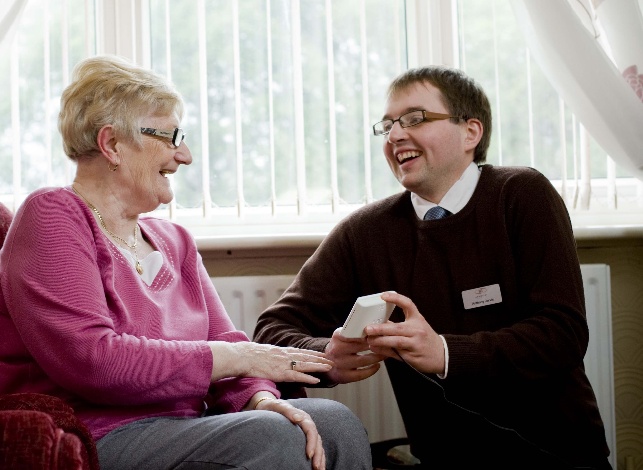
WINNER: ‘Save energy, save money’ project - Knowsley Housing Trust
QUICK ECO-CREDENTIALS: A host of low-cost programmes to help residents reduce their energy use which have saved £815,000 and 176 tonnes of CO2 in a year
WHAT THE JUDGES SAID: “Knowsley Housing Trust’s programmes reached a lot of residents. They looked at all the issues and dealt with them. They showed effective thinking around making lasting changes.”
Key green features
- The project provides free and low-cost ways to help residents and communities warm their homes affordably. It has saved £815,000 and 176 tonnes of CO2 in the past year for a budget of under £15,000, supplemented by some external funding.
- In future Knowsley Housing Trust will put some income from selling energy generated by its solar photovoltaic panels to the programme.
- The project includes a home energy audit service to help the trust’s residents cut their energy use.
- Knowsley Housing Trust now also delivers the Warm Homes Discount pilot for energy firm Eon to all the borough’s residents - not just trust tenants.
- Over 12 months it has completed more than 1,000 assessments, and made savings of more than £68,000 and 96 tonnes of CO2 a year, while providing jobs and training for 15 young people who were unemployed and not studying.
Sustainable larger housing retrofit project of the year
Sponsor: Ecopod
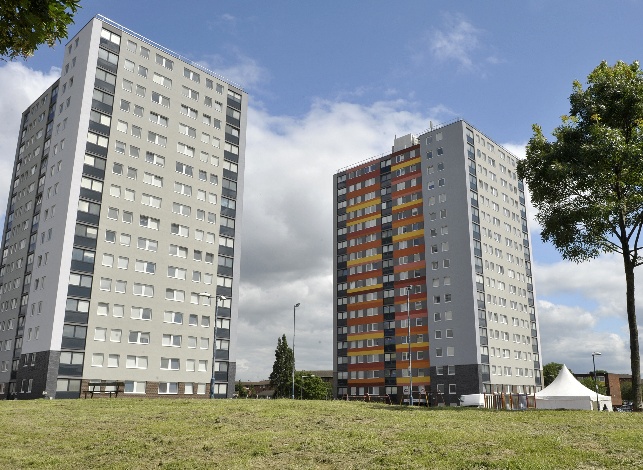
Source: Spencer Griffiths
WINNER: United House
WHAT: Colne and Mersea retrofit
WHERE: London Borough of Barking & Dagenham
QUICK ECO-CREDENTIALS: United House says this is the most advanced sustainable retrofit of tower blocks in the UK
WHAT THE JUDGES SAID: “It’s good they managed to use no scaffolding. Community engagement was also excellent.”
Key green features
- This project bought 200 homes in two 17-storey tower blocks up to the decent homes standard as well as improving their energy efficiency.
- Both buildings’ standard assessment procedure rating - which measures the energy and environmental performance of buildings - increased from 37 to 75 with the potential to increase it to 90 out of 100 when connected to the London Thames Gateway Heat Network, a district heating system.
- The target is to reduce tenants’ fuel bills by 56 per cent and cut water consumption by half.
- The minimum goal of 10 per cent onsite renewable energy has been achieved by installing 261 photovolatic panels.
- Other measures include integral blinds and triple-glazed windows, externally insulated rendered cladding and an insulated roof.
Community involvement and engagement award
Sponsor: Breyer Group
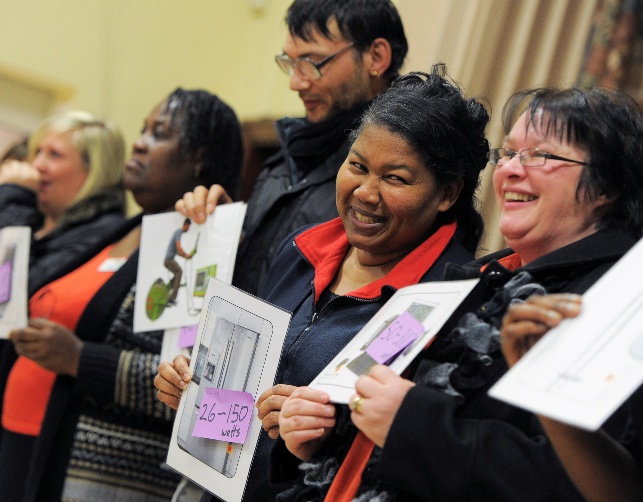
WINNER: Plugin - Environment Agency Midlands, Severn Trent Water, South Staffs Water, Global Action Plan, Wolverhampton Homes, Orbit Heart of England, Optima Community Housing Association, Black Country
WHAT: Scheme to help tenants cut their water use
WHERE: Midlands
QUICK ECO-CREDENTIALS: The water-saving products alone saved nearly 40,000 litres of water a day
WHAT THE JUDGES SAID: “The scheme is innovative in that it involved training maintenance staff. We liked that it focused on water, and also the way it quantified how much water has been used.”
Key green features
- The scheme provided water-saving equipment and advice to 3,300 homes including shower timers and efficient showerheads, which were installed as part of routine maintenance work.
- More than 250 tenants and staff received energy and water-saving training.
- One hundred and fifty residents went to meetings held by charity Global Action Plan. During the meetings they played games to improve understanding of water use and committed to various energy and water-saving measures which they would pass on to others as well as more eco-friendly ways of travelling and purchasing, such as buying less or buying second-hand products.
- Eight residents became eco-champions, who promote energy and water savings to other residents.
- Maintenance teams were taught how to explain the water-saving products and how to save water and energy.
The judges
- Sophie Atkinson, group sustainability manager, Sanctuary
- Richard Baines, director of sustainable development, Black Country Housing
- Victoria Cartwright, sustainability manager, Guinness Trust
- Andrew Eagles, managing director, Sustainable Homes
- Jennifer Hardi, consultant in housing future, BRE
- Catrin Maby, chief executive, Severn Wye Energy Agency
- Stuart Macdonald, editor, Inside Housing
- Neil May, project director, Good Homes Alliance
- Jess McCabe, editor, Sustainable Housing
- Denys Stephens, group sustainability manager, Devon & Cornwall Housing
This year’s Sustainable Housing Awards were presented by actor and mountaineer Brian Blessed at London’s Park Lane Hilton hotel on 19 October, with the drinks reception sponsored by Galliford Try Partnerships. For more pictures from the ceremony, visit www.insidehousing.co.uk/events

